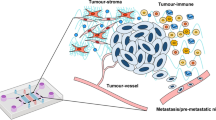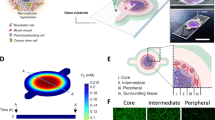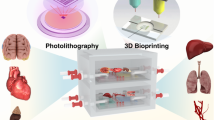Abstract
As an advanced cell culture platform, the organ-on-a-chip has been in the spotlight recently owing to its ability to maintain the physiological characteristics of cells in vitro. Therefore, several disease models have been developed using the organ-on-a-chip technology, and the organ specific three-dimensional (3D) structure and various mechanical/chemical stimuli built into the chip enable efficient development of drugs, medical devices, and biomaterials, as well as realization of patient-specific precise medicine. This study introduces a novel chip-based non-muscle invasive bladder cancer model, multilayered tissue-on-a-chip (MToC), which was created using 3D bio-printing technology, micro-milling, and soft lithography based polydimethylsiloxane (PDMS) casting. All types of cells, T24, MRC-5, and HUVEC, were successfully co-cultured in the MToC. Using computational fluid dynamics (CFD), the flow phenomena occurring in MToC were analyzed. Further, we attempted Bacillus Calmette–Guérin (BCG)-induced migration of THP-1, and the viability reduction of bladder cancer cells and the THP-1 migration were observed. Although follow-up studies are needed to precisely mimic the immune response, this partial phenomenon of the immune response suggests the potential of this device as a surrogate experimental tool for BCG immunotherapy in future.








Similar content being viewed by others
References
Lee, G.H., et al.: Networked concave microwell arrays for constructing 3D cell spheroids. Biofabrication 10, 015001 (2017)
Park, S.E., Georgescu, A., Huh, D.: Organoids-on-a-chip. Science 364, 960–965 (2019)
Kashaninejad, N., et al.: Organ-tumor-on-a-chip for chemosensitivity assay: a critical review. Micromachines 7, 130 (2016)
Liu, Y., et al.: Adipose-on-a-chip: a dynamic microphysiological in vitro model of the human adipose for immune-metabolic analysis in type II diabetes. Lab Chip 19, 241–253 (2019)
Tao, T., et al.: Engineering human islet organoids from iPSCs using an organ-on-chip platform. Lab Chip 19, 948–958 (2019)
Bulutoglu, B., et al.: A microfluidic patterned model of non-alcoholic fatty liver disease: applications to disease progression and zonation. Lab Chip 19, 3022–3031 (2019)
Lasli, S., et al.: A human liver-on-a-chip platform for modeling nonalcoholic fatty liver disease. Adv. Biosyst. 3, 1900104 (2019)
McCain, M.L., Sheehy, S.P., Grosberg, A., Goss, J.A., Parker, K.K.: Recapitulating maladaptive, multiscale remodeling of failing myocardium on a chip. Proc. Natl. Acad. Sci. USA 110, 9770–9775 (2013)
Villenave, R., et al.: Human gut-on-a-chip supports polarized infection of coxsackie B1 virus in vitro. PLoS One 12, e0169412 (2017)
Van Den Berg, A., Mummery, C.L., Passier, R., Van der Meer, A.D.: Personalised organs-on-chips: functional testing for precision medicine. Lab Chip 19, 198–205 (2019)
Sievert, K.D., et al.: Economic aspects of bladder cancer: what are the benefits and costs? World J. Urol. 27, 295–300 (2009)
Kamat, A.M., et al.: Bladder cancer. Lancet 388, 2796–2810 (2016)
Zuiverloon, T.C.M., et al.: Markers predicting response to bacillus Calmette–Guérin immunotherapy in high-risk bladder cancer patients: a systematic review. Eur. Urol. 61, 128–145 (2012)
Andersson, K., McCloskey, K.D.: Lamina propria: the functional center of the bladder? Neurourol. Urodyn. 33, 9–16 (2014)
Kim, J.H., et al.: Establishment of three-dimensional bioprinted bladder cancer-on-a-chip with a microfluidic system using Bacillus Calmette–Guérin. Int. J. Mol. Sci. 22, 8887 (2021)
Kim, M.J., et al.: Structure establishment of three-dimensional (3D) cell culture printing model for bladder cancer. PLoS One 14, e0223689 (2019)
Park, J.Y., Yoo, S.J., Hwang, C.M., Lee, S.H.: Simultaneous generation of chemical concentration and mechanical shear stress gradients using microfluidic osmotic flow comparable to interstitial flow. Lab Chip 9, 2194–2202 (2009)
Swartz, M.A., Fleury, M.E.: Interstitial flow and its effects in soft tissues. Annu. Rev. Biomed. Eng. 9, 229–256 (2007)
Ng, C.P., Helm, C.L.E., Swartz, M.A.: Interstitial flow differentially stimulates blood and lymphatic endothelial cell morphogenesis in vitro. Microvasc. Res. 68, 258–264 (2004)
Helm, C.L.E., Fleury, M.E., Zisch, A.H., Boschetti, F., Swartz, M.A.: Synergy between interstitial flow and VEGF directs capillary morphogenesis in vitro through a gradient amplification mechanism. Proc. Natl. Acad. Sci. USA 102, 15779–15784 (2005)
Helm, C.L.E., Zisch, A., Swartz, M.A.: Engineered blood and lymphatic capillaries in 3-D VEGF-fibrin-collagen matrices with interstitial flow. Biotechnol. Bioeng. 96, 167–176 (2007)
Boardman, K.C., Swartz, M.A.: Interstitial flow as a guide for lymphangiogenesis. Circ. Res. 92, 801–808 (2003)
Semino, C.E., Kamm, R.D., Lauffenburger, D.A.: Autocrine EGF receptor activation mediates endothelial cell migration and vascular morphogenesis induced by VEGF under interstitial flow. Exp. Cell Res. 312, 289–298 (2006)
Maroudas, A., Bullough, P.: Permeability of articular cartilage. Nature 219, 1260–1261 (1968)
Mow, V.C., Holmes, M.H., Michael, L.W.: Fluid transport and mechanical properties of articular cartilage: a review. J. Biomech. 17, 377–394 (1984)
Sah, R.L., et al.: Biosynthetic response of cartilage explants to dynamic compression. J. Orthop. Res. 7, 619–636 (1989)
Grodzinsky, A.J., Levenston, M.E., Jin, M., Frank, E.H.: Cartilage tissue remodeling in response to mechanical forces. Annu. Rev. Biomed. Eng. 2, 691–713 (2000)
Ng, C.P., Swartz, M.A.: Fibroblast alignment under interstitial fluid flow using a novel 3-D tissue culture model. Am. J. Physiol. Hear. Circ. Physiol. 284, 1771–1777 (2003)
Ng, C.P., Swartz, M.A.: Mechanisms of interstitial flow-induced remodeling of fibroblast-collagen cultures. Ann. Biomed. Eng. 34, 446–454 (2006)
Wang, S., Tarbell, J.M.: Effect of fluid flow on smooth muscle cells in a 3-dimensional collagen gel model. Arterioscler. Thromb. Vasc. Biol. 20, 2220–2225 (2000)
Kim, S.H., Ahn, K., Park, J.Y.: Responses of human adipose-derived stem cells to interstitial level of extremely low shear flows regarding differentiation, morphology, and proliferation. Lab Chip 17, 2115–2124 (2017)
Hsu, Y.-H., Moya, M.L., Hughes, C.C.W., George, S.C., Lee, A.P.: A microfluidic platform for generating large-scale nearly identical human microphysiological vascularized tissue arrays. Lab Chip 13, 2990–2998 (2013)
Fluent, A.I.: 17.0 ANSYS fluent theory guide. ANSYS Inc, Canonsburg (2016)
Larsen, E.S., Joensen, U.N., Poulsen, A.M., Goletti, D., Johansen, I.S.: Bacillus Calmette–Guérin immunotherapy for bladder cancer: a review of immunological aspects, clinical effects and BCG infections. APMIS 128, 92–103 (2020)
White, F.: Fluid mechanics. McGraw-Hill Higher Education, New York (2015)
Walker-Samuel, S., et al.: Investigating low-velocity fluid flow in tumors with convection-MRI. Cancer Res. 78, 1859–1872 (2018)
Jackson, A.M., et al.: Changes in urinary cytokines and soluble intercellular adhesion molecule-1 (ICAM-1) in bladder cancer patients after Bacillus Calmette–Guérin (BCG) immunotherapy. Clin. Exp. Immunol. 99, 369–375 (1995)
Acknowledgements
This research was supported by the National Research Foundation (NRF) of the Republic of Korea (NRF-2018R1D1A1A02050248 and NRF-2021R1A2C1004307 to IHC), the Basic Science Research Program (2019R1F1A1062123 to JYP), and the Bio & Medical Technology Development Program (2018M3A9H1023141 to JYP) of the NRF funded by the Korean government, MSIT.
Author information
Authors and Affiliations
Corresponding author
Ethics declarations
Conflict of interest
The authors declare that there is no conflict of interest.
Additional information
Publisher's Note
Springer Nature remains neutral with regard to jurisdictional claims in published maps and institutional affiliations.
Supplementary Information
Below is the link to the electronic supplementary material.
Rights and permissions
About this article
Cite this article
Lee, S., Kim, J.H., Kang, S.J. et al. Customized Multilayered Tissue-on-a-Chip (MToC) to Simulate Bacillus Calmette–Guérin (BCG) Immunotherapy for Bladder Cancer Treatment. BioChip J 16, 67–81 (2022). https://doi.org/10.1007/s13206-022-00047-2
Received:
Revised:
Accepted:
Published:
Issue Date:
DOI: https://doi.org/10.1007/s13206-022-00047-2




